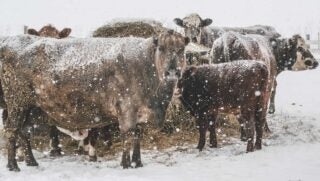After hearing arguments last week from the New Mexico Cattle Growers’ Association, Humane Farming Association, Spur Lake Cattle Company, and others, the U.S. District Court said that the gunning down of 150 head of cattle on New Mexico’s Gila Wilderness could commence.
While allegedly aiming to protect habitat and wilderness users, the four-day slaughter will leave an estimated 65 tons of beef left to rot in the Wilderness area. The shooting was set to begin last Thursday and end over the weekend, but there has been no report on the USFS’s “success” yet.
“Unfortunately, the slaughter is moving forward. With pressure from environmental groups and because of the rugged and vast terrain, the Forest Service feels this is the most humane way to deal with the immediate removal of the cattle,” R-CALF USA wrote in a statement. “We call on the Forest Service to step back and consider other options, such as seeking applications for private individuals to gather the cattle over time or, at least, putting the meat from the estray cattle to good use such as for feeding people in need.”
The NMCGA’s application for a Temporary Restraining Order was filed last week to stop the aerial slaughter in the wilderness areas — arguing that the gunning was inhumane and put surrounding rancher’s cattle that may have escaped at risk.
Representing the Forest Service, U.S. Department of Justice attorney Andrew Smith argued that stopping the cull would allow wild cow populations to “rebound, and last year’s efforts would be wasted.”
Judge James Browning stated in his Memorandum Opinion and Order that preventing the USFS operation would be adverse to the public interest, citing that “the court does not see a legal prohibition on the operation. It would be contrary to the public interest to stop the operation from proceeding.”
Browning also stated that the USFS Scoping Letter issued on Nov. 22, 2022, provided sufficient notice to stakeholders to remove cattle from the wilderness area, noting that cattle are not “unauthorized livestock” because they are not “kept or raised for use or pleasure.”
“We are disappointed the Court decided it will not stop the USFS from its slaughter campaign,” said Loren Patterson, President of NMCGA. “Cattle Growers’ is dedicated to the long-term stewardship of New Mexico’s animals and land. Our industry and members recognize the right thing to do is not always the easiest or cheapest. We will continue to fight for the ethical and humane treatment of estray cattle in the Gila.”
More than that, the first New Mexico State Legislature defined “estray cattle” as any bovine animal found running at large upon public or private lands, publishing its definition in The New Mexico Brand Book and adopting those policies into state law.
According to the Definition of Estray, estray livestock and animals fall under the jurisdiction of the New Mexico Livestock Inspector. Estray animals also may not be taken up except in the county where that person resides, and that person must provide a written description of that animal within five days. And while federal law may, at times, supersede state law, NMCGA President Loren Patterson responded on social media by saying that the federal government needs a specific law to do so.
State officials responded to the ruling
The state’s governor, Lujan Grisham, stated in response to the shooting. “While I understand the challenge the U.S. Forest Service is rightly trying to solve. I am disappointed in their lack of meaningful, long-term engagement with New Mexico stakeholders on controversial matters like this one.” Grisham continued, “I implore the federal government to do better. As it stands, they are failing New Mexicans.”
New Mexico State Sen. Crystal Diamond also responded to the judge’s ruling, writing, “I am disappointed in the federal judge ruling to allow the aerial shooting of cattle to resume today. It remains my position that the mass shootings are not only inhumane, but unlawful.”
Diamond maintains that the killings violated the settlement terms of the 2022 lawsuit, requiring 75 days’ notice before any lethal killing of cattle. The plaintiffs argued in their suit that USFS only gave seven days’ notice.
Heidi Crnkovic, is the Associate Editor for AGDAILY. She is a New Mexico native with deep-seated roots in the Southwest and a passion for all things agriculture.



